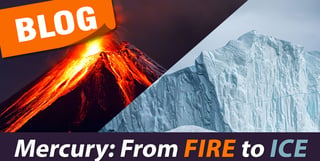 A lot of focus is put on anthropogenic (human-caused) releases of mercury into the environment, but let’s take a closer look into a powerful, natural source of mercury: volcanoes! We’ll explore why volcanic eruptions can increase global mercury levels, how we measure mercury released from past major eruptions, and how those measurements inform our policies for the future. So, how does mercury move from fire to ice?
A lot of focus is put on anthropogenic (human-caused) releases of mercury into the environment, but let’s take a closer look into a powerful, natural source of mercury: volcanoes! We’ll explore why volcanic eruptions can increase global mercury levels, how we measure mercury released from past major eruptions, and how those measurements inform our policies for the future. So, how does mercury move from fire to ice?
Volcanic eruptions occur in the form of magma. Originating miles beneath the ground, magma is made of molten rock and dissolved gases1. Mercury is naturally present in raw materials such as coal, crude oil, and cinnabar ore. The most common geological deposit of mercury is cinnabar, a mercury sulfide mineral that can be composed of up to 86 percent mercury. It is also present in other minerals, like limestone, and in some metal ores such as zinc, copper and gold2.
These mercury-containing materials become part of the molten magma mixture. Magma is driven towards Earth's surface by buoyancy. It is lighter than the surrounding rock and is driven by pressure from gas within it. Magma forces its way upward and may ultimately break though weak areas in the Earth's crust. If so, an eruption occurs3
When volcanoes erupt, they shoot scorching rock, ash, steam, and super-heated gases high into the atmosphere. This dense plume can travel great distances. For example, Mt. St. Helens’ ash plume was almost 15 miles high and caused dangerous conditions more than 300 miles away. In just under two weeks, the ash had encircled the entire globe, mercury settling along with the fine powder4.
There are a few ways to measure the mercury released from volcanic eruptions. To see historical depositions of mercury, we use ice core chronology. By taking ice cores from glaciers and measuring the level of mercury inside, we have a record of the order and amount that was deposited. The ice cores, totaling hundreds of meters in depth, are sampled and divided into sections a few centimeters long. The sections are then carefully melted and collected. The water samples can be analyzed for ultra-trace levels of mercury using cold vapor atomic fluorescence following USEPA method 1631. Besides mercury, the samples are also measured for chlorine levels and sulfate electrical conductivity. A correlation between these three analytes is a strong indicator of a volcanic source.
 Figure 1 shows ice core mercury concentrations in relation to year and historical events5. Note the three blue spikes for the major volcanic eruptions of Tambora, Krakatau, and Mt. St. Helens. To give some perspective into the scale of the two massive Indonesian eruptions, Tambora and Krakatau are about 12,000 miles away from the collection site and were orders of magnitude larger than the Mt. St. Helens eruption. Mt. St. Helens is only 300 miles away, so this area would have been blanketed in ash from that event. It’s amazing how those enormous eruptions from hundreds of years ago can be empirically recorded in ice halfway around the world!
Figure 1 shows ice core mercury concentrations in relation to year and historical events5. Note the three blue spikes for the major volcanic eruptions of Tambora, Krakatau, and Mt. St. Helens. To give some perspective into the scale of the two massive Indonesian eruptions, Tambora and Krakatau are about 12,000 miles away from the collection site and were orders of magnitude larger than the Mt. St. Helens eruption. Mt. St. Helens is only 300 miles away, so this area would have been blanketed in ash from that event. It’s amazing how those enormous eruptions from hundreds of years ago can be empirically recorded in ice halfway around the world!
The ice core mercury record can also tell us about the efficacy of policy put in place to reduce mercury usage. The yellow portion shown in Figure 1 corresponds to the California Gold Rush, which peaked in 1860 and again in 18775. In 1884, mercury production significantly decreased with the introduction of legislation (the Sawyer Decision) that greatly reduced the use of mercury for gold mining in California. This steep decline can be confirmed by the ice core records. The steady increase and sharp reduction in mercury emission shown in red represent modern industrialization. The sudden drop is thought to be a result of the Clean Air Amendment of 1990. The data presented was obtained in 1998; I would be interested in seeing the data for the following 25 years.
For more information on our analyzers and how they can help with your mercury analysis needs, please contact us or visit our website.
- Volcano Hazards. “About Volcanoes.” USGS, https://www.usgs.gov/programs/VHP/about-volcanoes#:~:text=They%20are%20made%20of%20small,and%20gas%20into%20the%20air.
- Environment and Climate Change Canada (ECCC). “Sources of mercury.” Government of Canada, https://www.canada.ca/en/environment-climate-change/services/pollutants/mercury-environment/about/sources.html.
- Volcano Hazards. “About Volcanoes.” USGS, https://www.usgs.gov/programs/VHP/about-volcanoes#:~:text=They%20are%20made%20of%20small,and%20gas%20into%20the%20air.
- “Footage of the 1980 Mount St. Helens Eruption”, uploaded by Smithsonian Channel, 29 Sep. 2017, https://www.youtube.com/watch?v=AYla6q3is6w
- Schuster, P. & Krabbenhoft, David & Naftz, D. & Cecil, L. & Olson, M. & Dewild, John & Susong, David & Green, J.. (2002). A 270-year Ice Core Record of Atmospheric Mercury Deposition to Western North America. https://pubs.acs.org/doi/10.1021/es0157503#.

